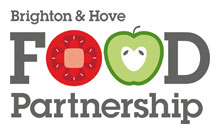Guest post by Dora Clouttick
Orchards without Borders, or Vergers sans Frontières in French, is a collaboration between Collines Normandes (CPIE), Brighton Permaculture Trust and Brighton & Hove Food Partnership. It is predominantly funded by INTERREG, an EU fund to promote collaboration between different regions within Europe, and its overall aim is to promote orchards as part of a sustainable food system. This is achieved through sharing skills and experiences across borders and between regions – Hurrah! I wanted to find out more and signed up as soon as I could.
Happily offered a place, I found myself at Newhaven one early morning in September.
We merrily tripped (or at least shipped) across La Manche, the name the French have for the Channel, from Sussex to Normandy, passing through a kite festival in Dieppe and arriving at our wonderfully decorative lodgings with impressively eco credentials and a magical garden, La Bergerie.
Evelyne Ramon, an especially fine, fun and knowledgeable environmental educator at CPIE, welcomed us, and we tucked into a four-course meal prepared by the owners Sylvie and Frederic.
With much laughter and far too much cheese, I was introduced to our motley crew:
- Anne Marie, our leader in chief whose vision and hard work helped bring the whole idea of orchards without borders into reality
- Patient Peter, with fathomless knowledge on all things apple, who is lost without his grafting knife
- Bryn, a phenomenal orchard planner and cheese addict
- Stephan, the never-tiring flirt and charmer who can single-handedly entertain numerous children (and adults) for hours given an apple press and enough apples
- Pam, an unstoppable force and gleaner of apples
- Debbie, Common Cause’s main gal and tender of Ringmer orchard, and
- Marie, a permaculture design graduate with whom I was lucky enough to share a house over the weekend.
Not knowing any of them beforehand, the realization that I was in particularly good company and in for a treat dawned on me, and I went to bed happy and eager for the next day.
Early the next morning, we were off and away to meet a local ornithologist at a nearby orchard to discover the intimate relationship between birds and apples. Etienne Lambert, stylishly attired in fabulous pink and green spectacles and well-worn wellies, led us striding into the orchard at Caligny, bird book and binoculars in hand.
He informed us that the highest biodiversity of inland birds in Normandy are found in orchards, mainly because of the hedgerows surrounding them and the nesting sites that fruit trees can provide.
 Because of the pruning that goes on in an orchard to ensure size and quality of fruit and manage disease, branches are removed, and the scars that are left can turn into holes in the trunk, creating coveted and precious nest sites for birds, especially blue tits.
Because of the pruning that goes on in an orchard to ensure size and quality of fruit and manage disease, branches are removed, and the scars that are left can turn into holes in the trunk, creating coveted and precious nest sites for birds, especially blue tits.
The blue tit / orchard story is a particularly lovely example of a ‘circular economy’. The blue tits feed on codling moth caterpillars, which as any orchardist knows are a big threat to harvest and apple tree health. In return, the apple trees provide nest sites for the blue tits, looking after them and ensuring their continued existence.
Further to this, Etienne told us that apple orchards, as opposed to other fruit orchards, are particularly rich in nesting holes. On average, you would get 1 nest site per 200 trees in an apple orchard, whereas in a plum orchard, for example, the ratio is more like 1 in 2000.
Birds found in Normandy orchards include the Cirl Bunting – hilariously and inexplicably called a bruant zizi in French which is best translated as the noisy willy bird – he he! (Note from Evelyne/Anne-Marie – ‘Hmmm… zizi here refers to the bird’s song- any other translation is quite wrong and very naughty). Little Owls, Yellow Hammers, and the Lesser Spotted and Green Woodpecker were also mentioned – the latter only found in orchards and nowhere else in Normandy, apparently.
We heard some of these species and also watched robins and tree creepers scuttling up tree trunks and flitting through the low pruned canopy, kept at a perfect height just out of reach of the tongues of cows that graze beneath.
Just when it couldn’t get any better, the apple grower himself came striding through the orchard fresh back from tending to a sick cow. His beautiful blue eyes shone with passion as he told us about the apples, the trees and the calvados which his family has been making for seven generations.
The morning was topped off with lunch and a tour round the calvados cave, and I got to taste a smidgeon of calvados from the year of my birth – delicious!
Note from Anne-Marie
Thanks, Dora, for this account of one of the activities we got up to on our recent study trip to Normandy!
We also visited a conservation orchard in Alencon. The man who planted it shared with us his knowledge of the history of orchards in Normandy, and we took part in the inspiring Faites des Legumes, where we planted a Sussex apple tree, pressed juice with the help of many children with a mix of Sussex and Normandy apples, and offered tastings of Sussex apples, apple juice from Ringmer community orchard, and local chutney and cakes. The exhibition about orchards that we and our French partners created – printed on hemp fabric in France, designed by CPIE – got its first outing here. Some of our party joined Evelyne on her foraging walk, and we were all impressed by the variety of stalls. Plant nurseries filled the site with September colour; local producers provided cheese, honey and cider; local groups promoted eco-gardening, seed swaps, and food waste reduction; and all day cows and ponies gave small children rides around the site.


Orchards without Borders was selected under the European Cross-border Cooperation Programme INTERREG IV A France (Channel) – England, co-funded by the ERDF